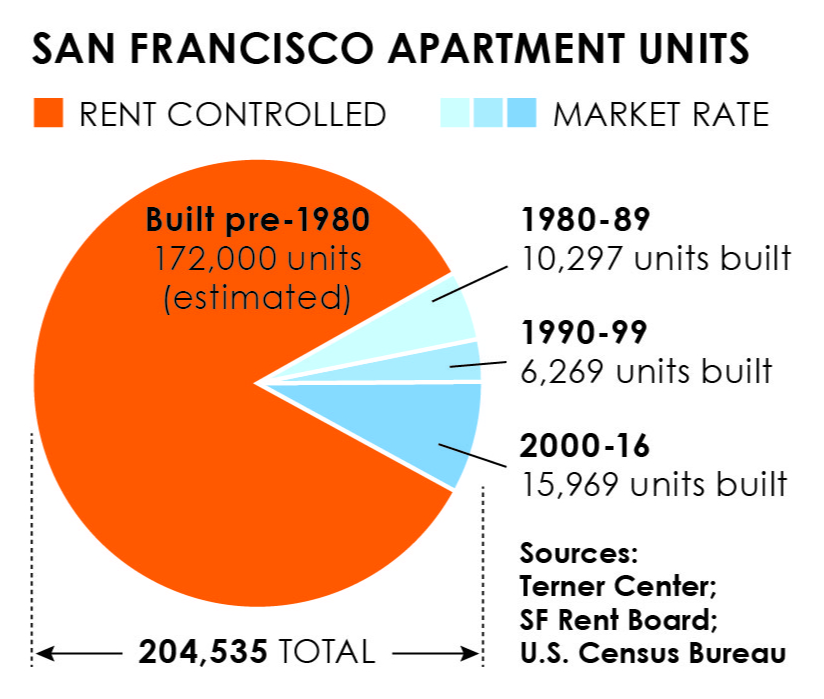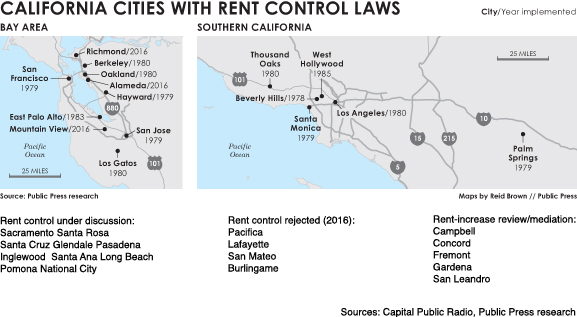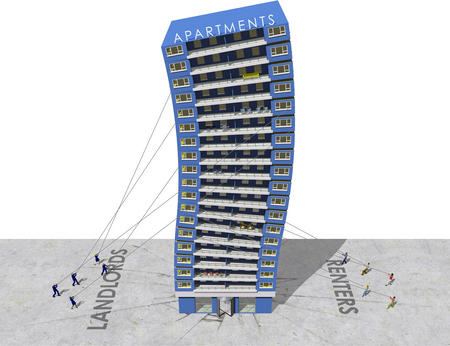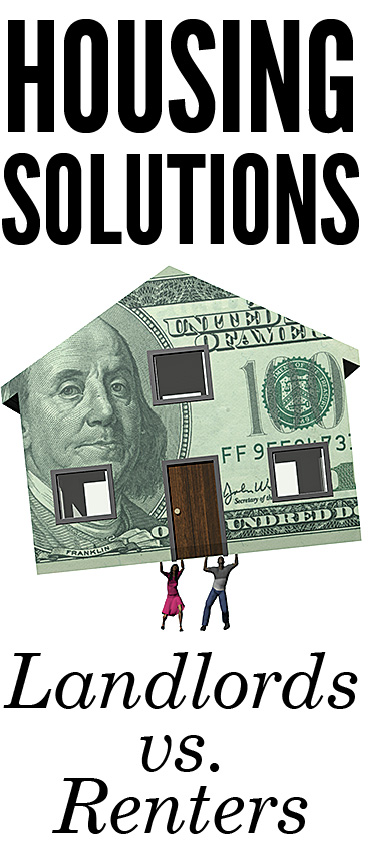Cities would regain power to regulate rental housing if Proposition 10 passes, repealing Costa-Hawkins. But would that expand affordable housing?
Back in spring, Berkeley’s rent board jumped out in front of San Francisco on a vote that could bring the most significant change to California housing in decades.
A grassroots campaign had just announced it had gathered enough signatures for Proposition 10, a statewide November ballot measure to repeal the Costa-Hawkins Rental Housing Act. The 1995 state law took power from local governments, restricting their ability to enact or expand rent-control laws.
If voters strike down Costa-Hawkins, cities will have new policy tools to help build more housing while trying to curb soaring rents and displacement.
Anticipating a repeal of the law, Berkeley officials moved quickly. They put a companion measure on the ballot, asking city voters to approve a novel policy — called “rolling” rent control in some circles — to apply rent control gradually to additional apartments for decades to come. It would also immediately apply to as many as 2,000 additional units in Berkeley, about 10 percent more than currently covered.
If adopted in San Francisco, it would extend rent control to at least 32,500 additional apartments — an almost 20 percent increase — and to thousands more in later years, based on estimates from UC Berkeley researchers.
The policy approach could reverse the loss of rent-controlled homes, and might be a compromise that real estate developers, landlords and tenant-rights groups could live with, said state Assemblyman Rob Bonta, an Oakland Democrat, who co-sponsored a legislative attempt to repeal Costa-Hawkins that failed in Sacramento in January.
“We get the new construction that we all want, and we get the additional rent-controlled units for those who need it,” Bonta said about rolling rent control. “What we have now is a broken system, obviously. If it worked, we wouldn’t have the biggest housing crisis in the state of California.”
“That’s why everything’s been on the table, including Costa-Hawkins, which has been for a long time a third rail,” he added.
Rolling rent control would retain existing tenant and landlord protections and apply them automatically to properties a predetermined number of years after construction, covering almost all current and future residential buildings. In other words, when a building hits a specific age, rents on apartments there could rise no faster than the allowed rate — even if they were luxury studios priced at $5,000 per month.
Rolling rent control was one of several potential housing solutions candidates raised during this year’s San Francisco mayoral campaign that were aimed at renters, who make up about two-thirds of all households. Although conceptually discussed in political circles for some time, it has received little academic scrutiny or attention from city planners, activists or landlords. Key players are intrigued by it, but hesitant to give full-throated support.
“My view is that all units should be rent controlled,” said Dean Preston, who is executive director of Tenants Together and a candidate for the District 5 supervisor seat that newly elected Mayor London Breed held. “The discussion should be around the details of what that means in different types of markets and different types of housing.”
To protect low- and middle-income workers and families from exorbitant increases and illegal evictions, many tenant groups favor expanding rent control immediately, not gradually, to all buildings — this is often called “universal” rent control. Developers and other real estate professionals argue that doing so could reduce the value of properties, and that blow to their profits would disrupt the market and stifle the creation of desperately needed housing.
This is where rolling rent control appears to be more workable, Bonta said. Because it would not affect a property’s value for many years, it “allows builders to make rational economic choices to build,” he said.
The key local policy choice then becomes the length of time between when a building is built and becomes regulated. A relatively short period could upend existing economic models for real estate investment, developers say. A longer period would be better.
Berkeley’s measure, which the City Council barely got onto the local ballot in an eleventh-hour vote in early August, would apply rent control to buildings 20 years after construction.
To market-rate developers, that’s way off.
“Twenty or 30 years is not enough,” said Denise Pinkston, of TMG Partners, one of the largest developers in the Bay Area. She serves on the Committee to House the Bay Area, which is crafting a regional strategy to ease the housing-affordability crisis.
This is just one example of the gulf between tenant and real estate interests, which will become increasingly pronounced in the run-up to the Nov. 6 election. Much hangs on the potential repeal of Costa-Hawkins and the lifting of rent control limits, a fight projected to cost $80 million, the Sacramento Bee reported in June.
Costa-Hawkins’ History
Rent control materialized in California in the late 1970s during a housing crisis similar to today’s. Between 1978 and 1985, more than a dozen cities placed limits on how much rents could rise — the annual allowed rate was generally tied to the regional Consumer Price Index — and provided eviction protections. The price controls affected only existing buildings.
In June 1979, the San Francisco Board of Supervisors enacted its own policy following a citywide rent freeze that spring, when the “problem of rent increases” had “reached crisis level,” as the ordinance states. Berkeley and four other cities — Santa Monica, West Hollywood, East Palo Alto and Cotati, in Sonoma County — adopted the more restrictive “vacancy control,” which curbed a landlord’s ability to increase the rent on an apartment when it turned over.
For more than a decade, landlord lobbyists repeatedly put bills before the Legislature to cut back these laws. State Sen. David Roberti, Senate president for 13 years and a champion of rent control, ensured that they failed. But in 1994, term limits forced the Los Angeles Democrat out.
Rent control’s opponents pounced. In 1995, with Democrats controlling both chambers and the governor’s mansion, legislators passed and Gov. Gray Davis enacted the Costa-Hawkins Rental Housing Act, sponsored by Sen. Jim Costa, a Democrat representing Fresno, and Assemblyman Phil Hawkins, a Republican representing Bellflower. (Willie Brown, who would later become mayor of San Francisco, voted against it as the Assembly speaker.)
The legislation outlawed vacancy control, as well as rent control on single-family homes. More important, it banned any regulation of rents in buildings constructed in later years.
That is why Richmond and Mountain View, where voters approved rent control in 2016, limit annual rent increases only in buildings constructed before 1995.
Costa-Hawkins also stated that, as of its passage, cities that already had rent caps could not extend them to additional buildings. That is why San Francisco cannot limit annual rent increases in the tens of thousands of buildings constructed after 1979.
Rental Housing: San Francisco
If no new buildings become rent controlled in California, their numbers will gradually drop as owners demolish or move into them, or withdraw from the rental business by pushing out tenants under the state’s Ellis Act.
San Francisco Rent Board documents show that, with fluctuations in some years, the city’s official count of rent-controlled units fell by almost 5 percent between fiscal 2004-05 and 2016-17, from about 181,000 units to 172,000. The board’s executive director, Robert Collins, said these tallies likely omit some units, though he would not speculate on how many.
If San Francisco enacted rolling rent control, it is unclear how many units would fall under its purview each year. A precise forecast would require knowledge of every building’s age, and the San Francisco Assessor-Recorder’s Office has not systematically tracked this information.
The Terner Center for Housing Innovation at UC Berkeley used U.S. Census Bureau data to estimate the number of buildings constructed in some major cities with rent control. This was part of a May paper that explored rolling rent control and other policy ideas with the potential to ameliorate the housing crisis.
Researchers estimated that 32,535 units in San Francisco buildings weren’t rent controlled because they were built from 1980 through the end of 2016, the last year studied. Of those, 10,297 units were built in the 1980s, 6,269 in the 1990s, 9,917 in the 2000s, and 6,052 from 2010 to 2016.
If, in 2020, San Francisco enacted a rolling rent-control policy that mirrored Berkeley’s ballot measure — applying rent control to any building at least 20 years old — then about 16,500 units would be old enough to become rent controlled immediately. After that, newer units would gradually phase in: A rough average of 950 units would become rent controlled annually, with fluctuations in that rate reflecting the historical pace of construction.
And building is still going strong. In 2017 alone, thousands more units were built in the city, according to the Planning Department’s most recent Housing Inventory report. Tens of thousands more are somewhere in the development process, from filing initial permits to construction.
Rolling Rent Control: Berkeley
In Berkeley, the rent board staff estimates that rolling rent control would apply immediately to between 1,106 and 2,000 housing units that were already old enough, and roughly 150 more units each year thereafter, on top of the roughly 20,500 that are already rent controlled.
This would occur at a time when the policy’s reach was greatly expanded. Without Costa-Hawkins, rent control would again apply to single-family homes in cities that did not expressly exempt them. San Francisco has such an exemption. Berkeley does not.
Rent board staffers said Berkeley’s proposal corrects a flaw in the language of Costa-Hawkins, which, in banning new construction from rent control, defines “new” as anything built after the law’s passage in 1995.
“It’s absurd to be calling something that was built 38 years ago new construction,” said Jay Kelekian, executive director of the Berkeley Rent Stabilization Board. He and his staff decided that “new” should be a temporary, rather than a permanent, designation.
Berkeley would not be the first jurisdiction to apply rent control in a time-release fashion. This type of policy has existed in New Jersey since 1999, when the Legislature there passed a law exempting new construction from local rent-control regulations for 30 years — the exemption is waived in certain cases in which owners pay off their mortgages sooner. Kelekian’s staff said that, in more than 100 New Jersey cities with rent control, few owners have paid off their mortgages to date. And in the Canadian province of Manitoba, a form of rolling rent control has existed since 1982. Because these policies and housing markets are complex and in many ways unique, it is difficult to draw from their histories to speculate on rolling rent control’s impact anywhere else.
How Long to Phase In?
In an effort to craft a rolling rent control policy that avoided disrupting real estate development, Bren Darrow, the Berkeley Rent Stabilization Board’s staff attorney, and his colleagues interviewed a range of professionals to understand the underlying market forces at play. The team consulted Berkeley’s former housing director, a city planner, developers, and financial and legal experts. They consulted only one market-rate developer, a family friend of Darrow’s.
“I was hoping that I could get a no-nonsense perspective from affordable-housing developers,” Darrow said, “as contrasted with some of the rhetoric that the Planning Department hears from developers of market-rate projects.” The team’s broad takeaway: A building’s revenue potential would decrease when it became rent controlled because the landlord could no longer raise rents to the market rate at any time. Instead, rents could rise no faster than Berkeley’s annually allowed rate, which changes from year to year and was 2.3 percent in 2018. (San Francisco’s latest is 1.75 percent.)
If developers knew they would make less money from the sale of a project, Darrow said, they could have a harder time getting financing. They might have to spend more time raising money before beginning construction, or take out more loans, exposing themselves to greater financial risk. This would slow individual projects or spur some developers to build in a different city.
An investment adviser told Darrow’s team that a rolling rent control law might be able to shield a project’s initial sale price — and a developer’s profits — if rent control were delayed by more than a decade after completion. That’s because the future buyer would probably intend to sell it later for a profit, and buyers typically run a 10-year analysis to weigh a purchase.
But there was no magic number of years that would maximize profits in every instance, Darrow found. No two buyers, or projects, are the same. Vacant land is hard to find in Berkeley and projects must often augment or replace existing structures, all of which affect the final cost.
And there are many strategies for developing properties.
“There are some people who develop properties and hold them long term,” Darrow said at a May 21 meeting of the rent board. Other developers invest all their resources into a project, sell it and use the revenue to build their next project. “And so, if they’re left with significantly less funds at the end of the cycle of building and then selling the property, they will be able to develop only a smaller property the next time,” Darrow said.
The 40-Year Window
Berkeley city staff weren’t the only ones trying to understand how rolling rent control might affect the housing market.
In May, the Terner Center published “Finding Common Ground on Rent Control,” a paper arguing that California would need to “look beyond Costa-Hawkins and jurisdiction-by-jurisdiction rent control ordinances” to give relief to low-income residents. The authors proposed capping annual rent increases for all buildings at 5 percent above the regional Consumer Price Index, as well as giving property owners a tax incentive to create and maintain affordable housing.
And, though the team speculated that their two statewide proposals would be more politically viable, they also examined rolling rent control and rent control on single-family homes.
This conclusion resulted from conversations with more than 30 market-rate developers, lenders and other professionals about how the policies might affect the feasibility of a hypothetical five-story, 100-unit apartment project. As in Berkeley, the center’s sources enjoyed anonymity because of how politicized this topic is.
In June, David Garcia, the center’s policy director, weighed in on an earlier version of Berkeley’s measure. At the time, officials were debating a phase-in period of between 12 and 15 years.
“From all the evidence that we’ve seen and collected,” he said, “that would most likely have a negative impact on new housing coming online in the city.”
“No one said that having a date is a nonstarter,” and there was no agreement on a specific number of years, Garcia said. But, he added, “we heard pretty clearly that anything less than 40 is probably going to see slowdown” in construction. That would give the owner a buffer to pay off a standard 30-year mortgage.
From a development lender’s perspective, recessions pose a special threat when layered with rolling rent control, Garcia said. That’s because, once the building is finished, rents are the major income source for the owner to repay that money.
“The idea is that during the life of your investment you are going to go through at least one, if not two, recessions where rents are going to stagnate a little or in fact decline,” Garcia said. Lower rents help new tenants, but eat into a landlord’s income. Normally, the owner could expect to recoup the loss by raising rents when the recession ends. But if that building becomes rent controlled in the midst of a recession, rents would be locked in for existing tenants.
This scenario could endanger a lender’s chance of ultimately being paid in full. To offset this risk, the borrower would be charged a hefty interest rate from the outset. “That is going to greatly increase your cost to financing,” Garcia said, “or a bank might not take that risk at all, or an investor might not take that risk either.”
Rolling rent control might also discourage owners from maintaining their properties. “At about 30 years, you’re looking at a complete overhaul of the building’s major systems,” such as electrical, plumbing, flooring and roofing, he said. “All of those things happen by year 30, if not before that.”
In addition to that work, which is legally required, the owner may choose not to replace or upgrade windows, carpeting, ventilation systems and lighting fixtures. “The theory is that I won’t make those improvements because I won’t be able to recoup those costs in enough time before those controls kick in,” Garcia said.
Oz Erickson, founder and principal of San Francisco-based developer Emerald Fund, echoed the Terner Center’s conclusion, saying that a rolling rent control policy would have to give concessions to developers.
For it to work, he said in an email, “there would have to be some absolute, hard-core guarantee that the regulatory entity (county, city, state?) would truly use fast-track approval and that rents would unquestionably be at market for 40 years. I am not sure how one would engineer this, but it might work.”
A shorter time frame would drive investors away, said Pinkston of TMG Partners.
“Development is risky,” she said. “You could make $10 million, or you could lose $30 million. And if capital can go invest in solar farms or chicken products, or commodities, versus housing, it will. It will make a better rate of return. And there is no market that is a private capital market that is as heavily regulated and controlled as housing is in California, which makes it more scarce, and therefore more expensive.”
This is not a new argument.
“The narrative that gets brought up every time there’s an imposition on developers in this city is that the imposition will prevent developers from developing new projects,” Darrow said, “because the new exaction from the city renders the project infeasible.”
So far, Berkeley regulations seem to have avoided drying up the housing market. Annual housing production fluctuated widely from 2007 to 2014, but in most years at least 100 units were built, according to the city’s most recent Housing Element. Berkeley’s Housing Pipeline Report shows that 910 units were built from 2014 to last September, at which point an additional 525 units were approved for construction.
Across the state, housing construction has generally declined since the 1970s, and this has been true in Berkeley and Alameda County, U.S. Census Bureau data show.
Public Dialogue Shifts
For nearly two years, Bonta fought to pass Assembly Bill 1506, the legislation to repeal Costa-Hawkins that he co-wrote with fellow Democratic assemblymen David Chiu, representing San Francisco, and Richard Bloom, representing Santa Monica. They tried to entice stakeholders by pitching policies that would become legal in absence of the state law.
Bonta floated rolling rent control about 50 times in conversations with tenant advocates, market-rate and affordable-housing developers, he said. “I like to raise it with everyone, take their temperature, see what they think.”
Bonta said that “probably 90 percent” of those people responded positively to the idea, which admittedly fell outside their publicly declared political agendas.
“There’s an openness to that being a landing spot for a deal,” he said.
But the prospect of rolling rent control proved inadequate to unite tenant and real estate groups behind AB 1506, which failed in committee in the Democrat-controlled Legislature.
“A lot of people see this not through a policy lens but through a political lens,” Bonta said. “Either it’s a landlord’s property right to be able to build and take the risks as businesspeople in the free marketplace, and turn a profit or rent out units, or it’s a tenant’s fundamental human right to housing.”
Recently, rolling rent control has begun to enter the public dialogue. San Francisco Supervisor Jane Kim, who represents the Tenderloin, Treasure Island and South of Market neighborhoods, was the only mayoral candidate in the June election to suggest it as a post-Costa-Hawkins scenario.
At a March candidates forum, an audience member asked how they would ensure housing for middle-income residents if elected. “Rolling rent control,” Kim said.
She called it “an ideal policy,” conceptually, but she’d like to see additional studies to determine the best phase-in period.
Like Kim, Breed has supported repealing Costa-Hawkins and expanding rent control in San Francisco, but she has not publicly addressed rolling rent control.
Scott Wiener, a former supervisor who represents San Francisco in the state Senate, has signaled interest. In April he told the Mercury News that Costa-Hawkins needs reform and that there is “something arbitrary” about allowing rent control only for properties built by 1995.
“Having some number of years where you eventually roll into rent control, I think that is a worthy topic of discussion,” he said. “I hope the conversation goes in that direction.”
The Landlord-Tenant Divide
But executives at two property-owners’ groups said rolling rent control would be little more than an expansion of flawed local laws that financially burden landlords.
Charley Goss, government affairs manager for the San Francisco Apartment Association, criticized rent control for sometimes benefiting “wealthy” renters who “have been able to hold on to their rent-control units for low cost.”
“I think there’s still something arbitrary about it, as to who it would protect,” he said. “Who should benefit from artificially low rent? I think the intuitive answer is low-income people.”
Between 1990 and 2015, an increasing proportion of the city’s rent-controlled units have gone to middle-income earners, according to a 2018 Planning Department analysis that calibrated dollars to 2015 levels. The fraction of tenants earning between 80 percent and 120 percent of the region’s median income ($57,100 and $85,600, respectively, for a single-person household) grew from about 1 percent to 28 percent, data show.
Goss would like the city to means-test rent-controlled tenants to identify and exempt people with high incomes from the annual limit on rent increases. If the city did this, he said, rolling rent control might become more palatable to his organization. The association represents about 4,000 landlords, most of whom manage properties with four units or fewer.
Means testing also has the support of Noni Richen, president of the Small Property Owners of San Francisco Institute, an organization that advocates for landlords.
Affordable-housing advocates are hesitant to support rolling rent control too, because it would leave thousands of tenants in more recently built homes exposed to unregulated rent increases for years or decades.
Tommi Avicolli Mecca, director of counseling at the Housing Rights Committee, said his organization had not taken a position on rolling rent control. He would personally like to see universal rent control applied to all properties simultaneously. He said an incremental increase sounded like an unnecessary compromise.
“Given that we’re going to have to fight opposition anyway,” he said, “why not fight for what we really need?”
Universal rent control is not a radical idea, he added, “given the way that the San Francisco market works and how we always have these booms, and that means that lots of people get evicted — it increases homelessness.” The official 2017 biennial Point-in-Time homelessness count found that 69 percent of those surveyed said they had been city residents when they became homeless, and that more than half had lived in San Francisco for at least 10 years.
Avicolli Mecca said the fight over rent control reminded him of the struggle for gay rights in Philadelphia in the 1970s, when he and other activists might have settled for less than what they wanted. There, he fought for passage of the Fair Practices Ordinance, which outlawed discrimination in housing, the workplace and public accommodations. Supporters were encouraged to exempt churches and other entities from its requirements so politicians felt safer backing it, he said.
“We were always being pressured to make it more palatable,” he said. “I remember those arguments. I remember that struggle. And we chose to push for the whole thing.”
The ordinance failed in 1974, but it passed eight years later. “Yeah, it took longer,” Avicolli Mecca said. “But was it worth it? Yes. Because now what they have in Philly is a comprehensive gay-rights ordinance that does really protect people.”
Causa Justa Just Cause, which educates and organizes around housing issues, supports applying rent control immediately to all existing buildings if Costa-Hawkins is repealed, said Leticia Arce, its lead San Francisco organizer.
“It would be just unacceptable for us to be unable to pass universal rent control,” Arce said. “What would be the hesitation from the local elected officials, if the voters have spoken so clearly?”
Speaking personally, Arce said, if universal rent control failed, she “might be open to negotiating rolling rent control. But it’s really hard for me to even say.”
Deepa Varma, executive director of the San Francisco Tenants Union, called rolling rent control “quite a popular idea” and “widely talked about,” but said the organization had not taken a stance.
Ultimately, at its heart, the fight over Costa-Hawkins remains a fight over how much cities should be able to control their housing markets.
Pinkston said that to her and others in market-rate development, “The fear around the repeal is that it will be left to each jurisdiction to decide what they want to do, and many of them will decide to cover new construction, which is another form of growth control.”
Developers bemoan the regulatory maze they must navigate, and say the repeal of statewide rent control limits might make development a more uncertain, risky and less profitable endeavor. Kelekian, the head of the Berkeley’s rent board, said that while he understands these concerns, cities aren’t acting irrationally by considering options to expand rent control.
“Those communities have just as great an interest in solving the problem — I’d say a greater interest — than the industry necessarily does,” Kelekian said. “That doesn’t mean they don’t care about it. But their assumption is that Berkeley, Santa Monica, West Hollywood, Emeryville, Albany will do something that they don’t think through, that exacerbates this situation in that city.
“And I think that cities have that self-interest to make sure they do it right.”





A version of this article also appears in the summer 2018 print edition of the Public Press.
Hear reporter Noah Arroyo discuss rent control and Proposition 10 on KALW’s Your Call with Rose Aguilar.











